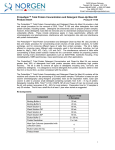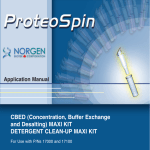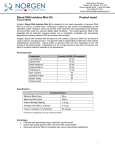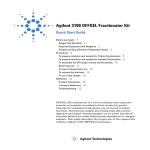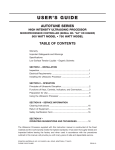Download 23350 - Protocol - Norgen Biotek Corp.
Transcript
3430 Schmon Parkway Thorold, ON, Canada L2V 4Y6 Phone: 866-667-4362 (905) 227-8848 Fax: (905) 227-1061 Email: [email protected] ProteoSpin™ Total Protein Concentration and Detergent Clean-Up Mini Kit Product Insert Product # 23350 The ProteoSpin™ Total Protein Concentration and Detergent Clean-Up Mini Kit provides a fast ® and simple procedure for the removal of SDS, Triton X-100 and other detergents from total protein samples, including lysates. Detergents are extensively used to prepare protein samples; however, these detergents must often be removed prior to downstream analysis because of their undesirable effects. These include extraneous peaks in mass spectrometry, artifacts with chromatography and electrophoresis, interference with microinjection into cells and interference with protein immunization. The ProteoSpin™ Total Protein Concentration and Detergent Clean-Up Mini Kit also provides a fast and simple procedure for concentrating small volumes of total protein solutions, for buffer exchange, and for removing different types of salts from protein samples. The kit is highly efficient in removing many different salts commonly used in the laboratory including, but not limited to, MgCl2, NaCl, KCl, CaCl2, LiCl and CsCl. The simultaneous removal of salts while concentrating a dilute protein solution makes the kit a convenient method for preparing proteins before running many downstream applications such as SDS-PAGE, isoelectric focusing, X-ray crystallography, NMR spectroscopy, mass spectroscopy and other applications. The ProteoSpin™ Total Protein Detergent Concentration and Clean-Up Mini Kit can remove greater than 95% of detergents from total protein samples while maintaining high protein recovery. The kit is able to remove all types of detergents including ionic, non-ionic and zwitterionic detergents. It is designed to remove detergents from protein solutions either in their free form or bound form, as when complexed with the protein. The ProteoSpin™ Total Protein Concentration and Detergent Clean-Up Mini Kit contains all the solutions and columns for the processing of 25 total protein samples. Purification is based on spin column chromatography using Norgen’s proprietary resin as the separation matrix. Each spin column is able to process small detergent-containing samples containing up to 200 g of protein. ® Detergents including SDS, Triton X-100, CHAPS, NP-40 and Tween 20 can be removed using the kit, with protein recoveries of 80 – 95% for most proteins. Preparation time for 12 samples is only 20 minutes. The kit has a shelf life of at least 1 year when stored as suggested. Kit Components Component Product # 23350 (25 samples) Binding Buffer A 4 mL Binding Buffer N 4 mL Wash Solution C 30 mL Wash Solution CIP 20 mL Wash Solution N 30 mL Wash Solution NIP 20 mL Elution Buffer C 8 mL Protein Neutralizer 4 mL Mini Spin Columns 25 Collection Tubes 25 Elution tubes (1.7 mL) 25 Product Insert 1 1 Storage Conditions and Product Stability All solutions should be kept tightly sealed and stored at room temperature. Once opened, the o solutions should be stored at 4 C. All the reagents should remain stable for at least 1 year in their unopened containers. Precautions and Disclaimers This kit is designed for research purposes only. It is not intended for diagnostic use. Ensure that a suitable lab coat, disposable gloves and protective goggles are worn when working with chemicals. For more information, please consult the appropriate Material Safety Data Sheets (MSDSs). These are available as convenient PDF files online at www.norgenbiotek.com. Customer-Supplied Reagents and Equipment Benchtop microcentrifuge Micropipettors 1.5 mL microcentrifuge tubes Isopropanol ® Milli-Q water Other elution buffers (optional) pH indicator paper Notes prior to use All centrifugation steps are carried out in a benchtop microcentrifuge at 6,700 x g (~10,000 RPM) except where noted. Please check your microcentrifuge specifications to ensure proper speed. Performance of the kit is not affected by temperature, and thus the procedure may be performed at room temperature, 4°C, or on ice. Ensure that all solutions are at room temperature prior to use, and that no precipitates have formed. If necessary, warm the solutions and mix well until the solutions become clear again. Ensure that no more than 200 g of protein sample is used per column. Prepare a working concentration of Wash Solution CIP by adding 20 mL of isopropanol (to be provided by the user) to the supplied bottle containing Wash Solution CIP. This will give a final volume of 40 mL. The label on the bottle has a box that can be checked to indicate that isopropanol has been added. Prepare a working concentration of Wash Solution NIP by adding 20 mL of isopropanol (to be provided by the user) to the supplied bottle containing Wash Solution NIP. This will give a final volume of 40 mL. The label on the bottle has a box that can be checked to indicate that isopropanol has been added. Procedure The ProteoSpin™ Total Protein Concentration and Detergent Clean-Up Mini Kit comes with solutions for processing both acidic and basic proteins. Two procedures, one for acidic proteins and another for basic proteins, are described. Proteins with isoelectric points (pI) of less than 7 are by definition acidic proteins. However, for purposes of using the kit, the protocol for acidic proteins applies to any protein whose pI is less than 8.0. Proteins with pI higher than 8.0 are purified using the protocol for basic proteins (See Figure 1 below). If the pI of the protein being purified is not known, the theoretical pI may be calculated using the web-based applications at http://us.expasy.org/tools/pi_tool.html. 2 Figure 1. Choosing a procedure based on the isoelectric point (pI). Protocol 1. Concentration of Protein Samples and Detergent Clean-up (Acidic Protocol) 1. Sample Preparation This step ensures that the protein solution is at the proper pH for column binding. a. Obtain protein sample. If particulates are present, clarify the sample through either filtration or centrifugation. b. Determine the pH and volume of the protein sample. c. Adjust the pH of the protein sample to 3.5 - 4 (for total protein concentration) or to your desired pH (according to the pI of your protein of interest) using the Binding Buffer A and mix content well. d. Verify that the pH is between 3.5 - 4, and add more Binding Buffer A if necessary. Binding Buffer N can be used to re-adjust your pH. Note 1: If the protein solution is already at the desired pH or lower, Binding Buffer A does not need to be added. Note 2: In some concentrated protein samples, precipitation may occur with the addition of the Binding Buffer A. This precipitate includes proteins, and thus should not be discarded. The precipitate should be resuspended as much as possible, and loaded onto the column with the rest of the sample. e. Add one volume of isopropanol to the pH-adjusted solution and mix well. 2. Column Activation a. Assemble a spin column with a provided collection tube. Open the cap on the column. b. Apply 250 L of Wash Solution CIP (after the addition of Isopropanol) to the column and close the cap. c. Centrifuge for one minute and discard the flowthrough. d. Repeat steps 2b and 2c to complete the column activation step. 3. Protein Binding a. Apply a maximum of 650 L of protein solution (from the Sample Preparation step) onto the column and centrifuge for one minute. b. Discard the flowthrough. Reassemble the spin column with its collection tube. Note: If desired, the flowthrough can be saved in a fresh tube for assessing your protein’s binding efficiency. 3 c. Depending on your sample volume, repeat steps 3a and 3b until the entire protein sample has been applied to the column. d. Discard any remaining flowthrough and reassemble the spin column with its collection tube. 4. Column Wash a. Apply 250 L of Wash Solution CIP (after the addition of Isopropanol) to the column and centrifuge for one minute. b. Discard the flowthrough and reassemble the spin column with its collection tube. c. Add 250 L of Wash Solution C to the column and centrifuge for one minute. d. Inspect the column and ensure that the liquid has passed through into the collection tube. There should be no liquid in the column. If necessary, spin for an additional minute to dry. 5. Protein Elution The supplied Elution Buffer consists of 10 mM sodium phosphate pH 12.5. Consult Appendix A (Optional Elution Buffers) for a list of alternative elution solutions that have been tested with the kit. a. Add 9.3 L Protein Neutralizer to a provided 1.7 mL Elution tube. b. Transfer the spin column from the Column Wash procedure into the Elution tube. c. Apply 100 L of Elution Buffer C to the column and centrifuge for 2 minutes at 200 x g (~2,000 RPM), followed by 1 minute at 6,700 x g (~10,000 RPM) Note the volume eluted from the column. Note: Approximately 95% of bound protein is recovered in the first elution. If desired, a second elution using 50 L of Elution Buffer C may be carried out. This should be collected into a different tube (to which 4.65 L of Protein Neutralizer is pre-added) to prevent dilution of the first two elutions. Protocol 2. Concentration of Protein Samples Not Containing Detergent (Acidic Protocol) 1. Sample Preparation This step ensures that the protein solution is at the proper pH for column binding. a. Obtain protein sample. If particulates are present, clarify the sample through either filtration or centrifugation. b. Determine the pH and volume of the protein sample. c. Adjust the pH of the protein sample to 3.5 - 4 (for total protein concentration) or to your desired pH (according to the pI of your protein of interest) using the Binding Buffer A and mix content well. d. Verify that the pH is between 3.5 - 4, and add more Binding Buffer A if necessary. Binding Buffer N can be used to re-adjust your pH. Note 1: If the protein solution is already at the desired pH or lower, Binding Buffer A does not need to be added. Note 2: In some concentrated protein samples, precipitation may occur with the addition of the Binding Buffer A. This precipitate includes proteins, and thus should not be discarded. The precipitate should be resuspended as much as possible, and loaded onto the column with the rest of the sample. 4 2. Column Activation a. Assemble a spin column with a provided collection tube. Open the cap on the column. b. Apply 250 L of Wash Solution C to the column and close the cap. c. Centrifuge for one minute and discard the flowthrough. d. Repeat steps 2b and 2c to complete the column activation step. 3. Protein Binding a. Apply a maximum of 650 L of protein solution (from the Sample Preparation step) onto the column and centrifuge for one minute. b. Discard the flowthrough. Reassemble the spin column with its collection tube. Note: If desired, the flowthrough can be saved in a fresh tube for assessing your protein’s binding efficiency. c. Depending on your sample volume, repeat steps 3a and 3b until the entire protein sample has been applied to the column. d. Discard any remaining flowthrough and reassemble the spin column with its collection tube. 4. Column Wash a. Apply 250 L of Wash Solution C to the column and centrifuge for one minute. b. Discard the flowthrough and reassemble the spin column with its collection tube. c. Add 250 L of Wash Solution C to the column and centrifuge for one minute. d. Inspect the column and ensure that the liquid has passed through into the collection tube. There should be no liquid in the column. If necessary, spin for an additional minute to dry. 5. Protein Elution The supplied Elution Buffer consists of 10 mM sodium phosphate pH 12.5. Consult Appendix A (Optional Elution Buffers) for a list of alternative elution solutions that have been tested with the kit. a. Add 9.3 L Protein Neutralizer to a provided 1.7 mL Elution tube. b. Transfer the spin column from the Column Wash procedure into the Elution tube. c. Apply 100 L of Elution Buffer C to the column and centrifuge for 2 minutes at 200 x g (~2,000 RPM), followed by 1 minute at 6,700 x g (~10,000 RPM) Note the volume eluted from the column. Note: Approximately 95% of bound protein is recovered in the first elution. If desired, a second elution using 50 L of Elution Buffer C may be carried out. This should be collected into a different tube (to which 4.65 L of Protein Neutralizer is pre-added) to prevent dilution of the first two elutions. Protocol 3. Concentration of Protein Samples and Detergent Clean-up (Basic Protocol) 1. Sample Preparation This step ensures that the protein solution is at the proper pH for column binding. a. Obtain protein sample. If particulates are present, clarify the sample through either filtration or centrifugation. b. Determine the pH and volume of the protein sample. c. Adjust the pH of the protein sample to 7.0 using the Binding Buffer N. The amount of Binding Buffer N required will depend on the starting protein solution. If the starting protein solution is in water, then add one part of the Binding Buffer N to 50 parts of the protein solution. However, if the starting protein solution already contains a buffer, a 5 greater volume of Binding Buffer N may be needed depending on the sample’s buffer type and strength, as well as the type of protein. Table 1 below serves only as a guideline for the amount of Binding Buffer N to add for every milliliter of a protein solution in a 100 mM buffer to obtain pH 7.0. Please check the pH after mixing and add more Binding Buffer N if necessary to obtain the desired pH. Table 1. pH Adjustment for Basic Proteins Starting pH of Solution 4 5, 6 8, 9, 10 11, 12 Volume of Binding Buffer N per mL of protein solution (based on 100 mM buffered solution) 150 L 80 L 60 L 80 L d. Add one volume of isopropanol to the pH-adjusted solution and mix well. 2. Column Activation a. Assemble a spin column with a provided collection tube. Open the cap on the column. b. Apply 250 L of Wash Solution NIP (after the addition of isopropanol) to the column and close the cap. b. Centrifuge for one minute and discard the flowthrough. c. Repeat steps 2b and 2c to complete the column activation step. 3. Protein Binding a. Apply a maximum of 650 L of protein solution (from the Sample Preparation step) onto the column and centrifuge for one minute. b. Discard the flowthrough. Reassemble the spin column with its collection tube. Note: If desired, the flowthrough can be saved in a fresh tube for assessing your protein’s binding efficiency. c. Depending on your sample volume, repeat steps 3a and 3b until the entire protein sample has been applied to the column. d. Discard any remaining flowthrough and reassemble the spin column with its collection tube. 4. Column Wash a. Apply 250 L of Wash Solution NIP (after the addition of isopropanol) to the column and centrifuge for one minute. b. Discard the flowthrough and reassemble the spin column with its collection tube. c. Add 250 L of Wash Solution N to the column and centrifuge for one minute. d. Inspect the column and ensure that the liquid has passed through into the collection tube. There should be no liquid in the column. If necessary, spin for an additional minute to dry. 5. Protein Elution a. Add 9.3 L Protein Neutralizer to a provided 1.7 mL Elution tube. b. Transfer the spin column from the Column Wash procedure into the Elution tube. c. Apply 100 L of Elution Buffer C to the column and centrifuge for 2 minutes at 200 x g (~2,000 RPM), followed by 1 minute at 6,700 x g (~10,000 RPM) Note the volume eluted from the column. 6 Note: Approximately 95% of bound protein is recovered in the first elution. If desired, a second elution using 50 L of Elution Buffer C may be carried out. This should be collected into a different tube (to which 4.65 L of Protein Neutralizer is pre-added) to prevent dilution of the first two elutions. Protocol 4. Concentration of Protein Samples Not Containing Detergent (Basic Protocol) 1. Sample Preparation This step ensures that the protein solution is at the proper pH for column binding. a. Obtain protein sample. If particulates are present, clarify the sample through either filtration or centrifugation. b. Determine the pH and volume of the protein sample. c. Adjust the pH of the protein sample to 7.0 using the Binding Buffer N. The amount of Binding Buffer N required will depend on the starting protein solution. If the starting protein solution is in water, then add one part of the Binding Buffer N to 50 parts of the protein solution. However, if the starting protein solution already contains a buffer, a greater volume of Binding Buffer N may be needed depending on the sample’s buffer type and strength, as well as the type of protein. Table 2 below serves only as a guideline for the amount of Binding Buffer N to add for every milliliter of a protein solution in a 100 mM buffer to obtain pH 7.0. Please check the pH after mixing and add more Binding Buffer N if necessary to obtain the desired pH. Table 2. pH Adjustment for Basic Proteins Starting pH of Solution 4 5, 6 8, 9, 10 11, 12 Volume of Binding Buffer N per mL of protein solution (based on 100 mM buffered solution) 150 L 80 L 60 L 80 L 2. Column Activation a. Assemble a spin column with a provided collection tube. Open the cap on the column. b. Apply 250 L of Wash Solution N to the column and close the cap. d. Centrifuge for one minute and discard the flowthrough. e. Repeat steps 2b and 2c to complete the column activation step. 3. Protein Binding a. Apply a maximum of 650 L of protein solution (from the Sample Preparation step) onto the column and centrifuge for one minute. b. Discard the flowthrough. Reassemble the spin column with its collection tube. Note: If desired, the flowthrough can be saved in a fresh tube for assessing your protein’s binding efficiency. c. Depending on your sample volume, repeat steps 3a and 3b until the entire protein sample has been applied to the column. d. Discard any remaining flowthrough and reassemble the spin column with its collection tube. 7 4. Column Wash a. Apply 250 L of Wash Solution N to the column and centrifuge for one minute. b. Discard the flowthrough and reassemble the spin column with its collection tube. c. Add 250 L of Wash Solution N to the column and centrifuge for one minute. d. Inspect the column and ensure that the liquid has passed through into the collection tube. There should be no liquid in the column. If necessary, spin for an additional minute to dry. 5. Protein Elution a. Add 9.3 L Protein Neutralizer to a provided 1.7 mL Elution tube. b. Transfer the spin column from the Column Wash procedure into the Elution tube. c. Apply 100 L of Elution Buffer C to the column and centrifuge for 2 minutes at 200 x g (~2,000 RPM), followed by 1 minute at 6,700 x g (~10,000 RPM) Note the volume eluted from the column. Note: Approximately 95% of bound protein is recovered in the first elution. If desired, a second elution using 50 L of Elution Buffer C may be carried out. This should be collected into a different tube (to which 4.65 L of Protein Neutralizer is pre-added) to prevent dilution of the first two elutions. Appendix 1 Optional Elution Buffers Proteins bound to Norgen’s spin columns are eluted through pH-dependent mechanisms. The efficiency of protein elution depends on high pH above the pI of the protein to be purified. The pH of the elution buffer chosen must be at least one unit higher than the pI of the protein of interest. Solutions not provided with the ProteoSpin™ Total Protein Concentration and Detergent CleanUp Mini Kit may be utilized if they are more appropriate for your needs. The table below lists optional elution buffers and their observed efficiency when BSA is used as a test protein. Elution Buffers Approximate Protein Recovery 50 mM ammonium hydroxide (approximate pH 11) 70% 250 mM ammonium hydroxide (approximate pH 11) 70% 1 M ammonium hydroxide (approximate pH 11) 90% 1 M ethanolamine (approximate pH 9) 70-80% 50 mM sodium phosphate (approximate pH 12.5) 95% 500 mM sodium phosphate (approximate pH 12.5) <70% 100 mM sodium borate (approximate pH 12.5) 1 M Tris (approximate pH 12.5) 95 -100% 95% Technical Support Contact our Technical Support Team between the hours of 8:30 and 5:30 (Eastern Standard Time) at (905) 227-8848 or Toll Free at 1-866-667-4362. Technical support can also be obtained from our website (www.norgenbiotek.com) or through email at [email protected]. 8 Troubleshooting Guide Problem Protein solution does not flow through the column during the binding step Poor protein/peptide recovery Possible Cause Solution and Explanation Centrifugation speed was too low Check the centrifuge to ensure that it is capable of generating 6,700 x g. Sufficient centrifugal force is required to move the liquid phase through the resin. Centrifugation speeds may be increased to 14,000 x g, but this speed should not be exceeded. Inadequate spin time Spin an additional two minutes to ensure that the liquid is able to flow completely through the column. Cellular debris is present in the protein solution. Prior to the sample preparation step, filter the sample with a 0.45 M filter or spin down insoluble materials. Solid, insoluble materials can cause severe clogging problems. Protein solution is too viscous. Dilute the protein solution and adjust the pH to either 3.5 4 or 7 with the appropriate Binding Buffer. Highly viscous materials due to high protein concentrations can slow down flow rate significantly. Protein solution is not completely dissolved. Dissolve the sample in a larger amount of buffer. Solid, insoluble materials can cause clogging problems. Incorrect pH adjustment of protein sample. It is important that the proper amount of Binding Buffer be added to the total protein sample in order to adjust the pH prior to loading onto the column. Incorrect procedure was used. Eluted protein solution was not neutralized. Eluted protein is degraded Ensure that the acidic protocol was used for acidic proteins and the basic protocol was used for basic proteins. It is known that when basic proteins are bound with the acidic protocol, elution is inefficient because the basic proteins are bound too tightly. Add 9.3 L of Neutralizer to each 100 L of eluted total proteins in order to adjust the pH to neutral. Some proteins are sensitive to high pH, such as the elution buffer at pH 12.5. Eluted protein was not neutralized quickly enough. If eluted proteins are not used immediately, degradation will occur. We strongly suggest adding Neutralizer in order to lower the pH. Proteases may be present. Use protease inhibitors during all steps of the Sample Preparation. Bacterial contamination of protein solution. Prepare the protein sample with 0.015% sodium azide. 3430 Schmon Parkway, Thorold, ON Canada L2V 4Y6 Phone: (905) 227-8848 Fax: (905) 227-1061 Toll Free in North America: 1-866-667-4362 © 2014 Norgen Biotek Corp. PI23350-1-M14 9









